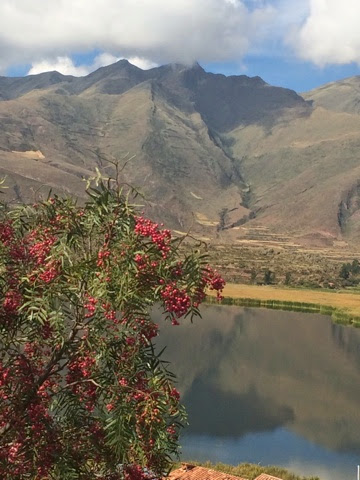We woke up a bit earlier than normal on Sunday to Mery's special bread and omlet breakfast--eggs filled with hot dogs and scallions. By 8:30, a bus pulled up outside our house to pick us up! Our new guide, Olmer was very enthusiastic on our bus ride to the southern region of Cusco to see Pikillacta and Tipon.
On the way, we made a pit stop at Huancarpay, an area containing a small town, a valley, and a lake. In Pre-Incan times, the small lake used to stretch across the entire valley, but today it is condensed to a small laguna that is is now considered a conservation. After taking a few photos, we hopped back into the bus to travel to Pikillacta! At Pikillacta, we saw an abundance of Pre-Incan architecture, mostly consisting of sections of walls. We also saw parts of a cemetary and a large enterway. Olmer told us that this place was most likely created by the Huwari group before the Incas or the Huarpas before them--although no one knows for sure. Unfortunately, the locals of the area have destroyed many parts of Pikillacta and only 5 percent of the total settlement can be seen today. We also learned a bit about the environment in Pikillacta. For example, it contains 35 species of humming birds and contains Maguay plants which are used to make paper. Olmer also pointed out the mountainous area nearby this area from which plaster is extracted. He also mentioned that the main problem in these mountains is the lack of water. It is very likely that within ten years, no water will be left in the areas near Pikillacta. It was sad to see how destroyed the ruins were and further, to learn about all of the environmental issues in this area.
The view at Huacaray:
The entryway at Pikillacta:
Pikillacta Ruins:
Cemetary at Pikillacta:
After Pikillacta, we boarded the bus to Tipon. On the way, we made a pit stop at a bakery to buy break specially made in Cusco called Chuta. The bread not only smelled amazing, but had an elegant appearance as well, with different shapes imprinted in the center of he large round pieces. We were also able to see the large oven in wich bread is baked almost every morning. Before departing, our group bought some bread to give to our host families, and we also bought a bag of smaller pieces of break called mollete to snack on in the bus.
Chuta Bread:
The Bread Oven:
Just a few more zig-zags up the mountain side and our bus arrived at Tipon. Tipon literally means spring, since it contains a natural spring that is harnessed by a series of acueducts. The acueduct technology was quite advanced and the ruins show signs that it was part of the Incan Empire, as part of the Incan Trail is connected to it. Since Tipon is hidden up the mountains and cannot be viewed from, there are theories that is was built as a palace for the Incan King to hide from enemies. Before the Incas, this site was most likely used by the Killky society, and Olmer surmises that during the Conquest of Peru, the Spanish most likely never arrived here. We walked around Tipon for a while, admiring the terraces and acueducts before returning to the bus for lunch. Our guide and driver provided us with a fressh box of meat and cheese empanadas, a delicacy that we were finally able to try for the first time. We also ate dellicious mandarins, cookies, and peace juice.
A view of Tipon:
The waterfalld and acueducts at Tipon:
After Tipon, we returned to the city of Cusco and headed to the San Pedro Market. Here, there are various clothing and souvenir shops, as well as a large area dedicated to produce, meats and other food. We were amazed to see three aisle of freshly made fruit joice, aisles with giant boar heads, and an aisle dedicated solely to chocolate (which tastes amazing, by the way). While our group roamed the market and spent time in a café, Dr. Shaw attended a Ballet, where she watched various interesting performances of different types of dance.
San Pedro Market:
Photos from the Ballet:
Closer to dinner time, some of the group went to the Chocolate Museum near the Plaza de Armas in Cusco, while others relaxed in a small plaza nearby. Finally, we all reunited to eat dinner at an elegante restaurant called Incanto. The food here was delicious, including the bread appetizer and everyone was very satisfied. To conclude the night, we returned to our homestay where we made thank you cards for Mary and the Vera Family, ate some cake, and retired to our rooms to repack our bags for the next morning for a new adventure. Puno!














No comments:
Post a Comment